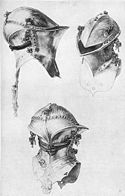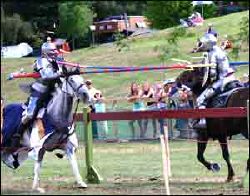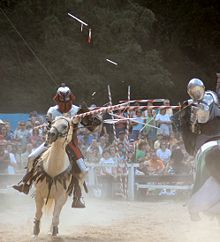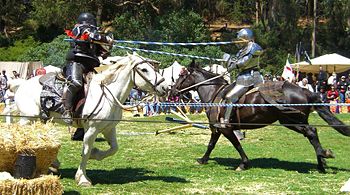Difference between revisions of "Jousting" - New World Encyclopedia
m (→Armor) |
|||
| Line 33: | Line 33: | ||
===Armor=== | ===Armor=== | ||
| + | [[Image:Lance rest on plate armour.jpg|thumb|left|Lance-rest built into 1565 plate armor.]] | ||
[[Image:Dürer Stechhelm.jpg|thumb|125px|Jousting helmet ''([[:de:Stechhelm|Stechhelm]])'', late fifteenth century. Illustration by [[Albrecht Dürer]].]] | [[Image:Dürer Stechhelm.jpg|thumb|125px|Jousting helmet ''([[:de:Stechhelm|Stechhelm]])'', late fifteenth century. Illustration by [[Albrecht Dürer]].]] | ||
| − | |||
Jousting was popular from the [[Middle Ages]] until the early 1600s. During that time, armor evolved from being [[chain mail]] (called simply mail at the time), with a solid, heavy helmet, called a "[[great helm]]," and shield. By 1400 knights wore full suits of [[plate armor]], called a "harness." A full harness frequently included extra pieces specifically for use in jousting, so that a light, military-combat suit could be reinforced with heavier, "bolt-on" protective plates on the [[cuirass]] (breastplate) and helmet, and also with jousting-specific arm and shoulder pieces, which traded mobility for extra protection. These extra pieces were usually much stronger on the side expected to take the impact of the lance. | Jousting was popular from the [[Middle Ages]] until the early 1600s. During that time, armor evolved from being [[chain mail]] (called simply mail at the time), with a solid, heavy helmet, called a "[[great helm]]," and shield. By 1400 knights wore full suits of [[plate armor]], called a "harness." A full harness frequently included extra pieces specifically for use in jousting, so that a light, military-combat suit could be reinforced with heavier, "bolt-on" protective plates on the [[cuirass]] (breastplate) and helmet, and also with jousting-specific arm and shoulder pieces, which traded mobility for extra protection. These extra pieces were usually much stronger on the side expected to take the impact of the lance. | ||
Revision as of 02:07, 2 January 2009
Jousting is a sport usually consisting of martial competition between two mounted knights or other horsemen using a variety of weapons, especially lances. However, jousts could also involve contests on foot with battle axes, swords, and daggers, or other weapons. Another form of jousting is tilting at the rings, in which the galloping rider attempts to insert his lance through small metal or wooden rings.
Jousting is thought to have originated as an informal friendly contest between knights and was later included as a prelude to the main mêlée event at medieval tournaments. The first recorded tournament was staged in 1066. However jousting did not gain in widespread popularity until the thirteenth century. In England, jousting was the highlight of the Accession Day tilts of Elizabeth I and James I, and also was part of the festivities at the marriage of Charles I. The sport maintained its status as a popular European event until the early seventeenth century and today has seen a modest resurgence at fairs and dinner theaters.
The joust permitted a display of individual skill and often offered large sums of prize money. Many knights made their fortune in these events, while others lost their wealth or even their lives. Most famous of these deaths resulted when a shard of an opponent's broken lance went through the visor and into the eye of Henry II of France in 1559.
Jousting and the tournament
Tournaments centered on the mêlée, a general fight where the knights were divided into two sides and came together in a charge, followed by general combat. Jousting, on the other hand, is single combat between two knights. Jousting was a component of the tournament, but not usually its main feature, serving instead as an evening prelude to the grand charge on the day of the main event. However, since it featured individual knights of substantial fame, it sometimes distracted knights from the main event. Count Philip of Flanders, for example, made a practice in the 1160s of turning up armed with his retinue to the preliminary jousts, and then delayed in joining the general mêlée until the initial battle was over. In the twelfth century jousting was occasionally banned in tournaments because of its tendency to distract from the main event.
By the early thirteenth century, however, jousting had its own devoted constituency, and in the 1220s jousting events began to be held outside the tournament. Called "Round Tables," these were essentially an elimination events, held for knights and squires alike, in which the winners of preliminary rounds would move on to the the level until only one champion remained. The first mention of an exclusively jousting event was the Round Table held in Cyprus by John d'Ibelin, Lord of Beirut in 1223. The biographer of William Marshal, 1st Earl of Pembroke observed shortly later that in his day, noblemen were more interested in jousting than tourneying. Other forms of jousting also arose—such as armed combat without horses and tilting at rings—and by the fourteenth century, with the decline of the tournament, jousting became the leading aristocratic sporting amusement.
The fourteenth century Chronicles of Froissart contains many details concerning jousting in medieval times. It relates that a war was even put on hold for a joust between the two sides. Other facets of the tradition mentioned in this source include:
- an expectation that no participants would be killed
- the use of attendants
- rounds consisting of three encounters with various weapons
- jousts being stopped when the risk of death was great
- financial rewards for top performers
- tilting was one form, but not the only type of jousting
- standards of conduct considered honorable
- the connection between romantic love and jousting
Field and equipment
The lists
The lists, or list field, constituted the roped-off arena in which a jousting event or similar tournament was held. In the late medieval period, castles and palaces were augmented with specially purpose-built tiltyards as a venue for jousting tournaments.
The skills and techniques used in jousting were first used in combat, as mounted knights would charge at their enemies with weapons to try to kill or disable them. The primary use of the jousting lance was to unhorse the other by striking them with the end of the lance while riding towards them at high speed. This is known as "tilting." Other weapons were used for jousting included maces, morning stars, various pole weapons, swords, and daggers.
Armor

Jousting was popular from the Middle Ages until the early 1600s. During that time, armor evolved from being chain mail (called simply mail at the time), with a solid, heavy helmet, called a "great helm," and shield. By 1400 knights wore full suits of plate armor, called a "harness." A full harness frequently included extra pieces specifically for use in jousting, so that a light, military-combat suit could be reinforced with heavier, "bolt-on" protective plates on the cuirass (breastplate) and helmet, and also with jousting-specific arm and shoulder pieces, which traded mobility for extra protection. These extra pieces were usually much stronger on the side expected to take the impact of the lance.
Special jousting helmets were sometimes used, made so that the wearer could only see out by leaning forwards. If the wearer straightened up just before the impact of the lance, the eyes would be completely protected. Some later suits had a small shield built-in the left side of the armor. In some cases, this was spring loaded to fly into pieces if struck properly by the opponent's lance.
The lance
Lances were often decorated with stripes or the colors of a knight's coat of arms. They were normally of solid oak and a significant strike was needed to shatter them. However, they intentionally kept blunt and would not usually penetrate the steel. The harnesses worn by the knights were lined on the inside with thick cloth to soften the blow from the lance. In modern times, jousting is often done for show or demonstration purposes, and the lances are usually made of light wood and prepared so that they break easily.
Horses
The two most common kinds of horse used for jousting were chargers and destriers. Chargers were medium-weight horses bred and trained for agility and stamina, while destriers were heavy warhorses. These were larger and slower, but helpful to give devastating force to the rider's lance, as its weight was about twice as much as a traditional riding horse. The horses were trained for "ambling," a pace designed to provide adequate speed and consequent force, while also giving the rider enough stability to focus and aim with the lance.
During a jousting tournament, the horses were cared for by their grooms in their respective tents. They wore caparisons, a type of ornamental cloth featuring the owner's heraldic signs. Competing horses had their heads protected by a chanfron, an iron shield for protection from otherwise lethal lance hits.
Other forms of equipment on the horse included long-necked spurs which enabled the rider to control the horse with extended legs, a saddle with a high back to provide leverage during the charge or when hit, as well as stirrups for the necessary leverage to deliver blows with the lance.
Modern-day jousting
Modern-day jousting, or tilting, has been kept alive by the International Jousting Association, [1], which has strict guidelines for the quality and authenticity of jousters' armor and equipment, and has developed the use of breakable lance tips for safety.
Jousting under the IJA rules follows a points system where points are given for breaking the lance tip on the opposing knights shield. However, there are no points given for unhorsing an opponent. IJA sanctioned tournaments also include skill at arms where the riders display their horsemanship and weapons handling skills with swords on the Moors Head, using spears for the rings and spear throw, and employing the lance against a spinning quintain. Many IJA tournaments also include a mounted melee with fully armored riders using padded batons in place of swords for safety. None of the IJA events are theatrically based and they offer the public a chance to observe living history as opposed to the Renaissance Fair-type of entertainment jousting.
Today, tent pegging is the only form of jousting officially recognized by the International Federation for Equestrian Sports. The sport involves using a lance or sword to strike and carry away a small wooden ground target. The name "tent pegging" is derived from the cavalry tactic of causing confusion in enemy camps by galloping though the camps and collapsing the tents by pulling up the tent peg anchors with well-placed lance tip strikes. The actual sport of tent pegging, however, originates in medieval India, when horse cavalrymen would try to incapacitate elephant cavalry by striking the elephants with lances on their extremely sensitive toenails[1].
Ring jousting is the official state sport of Maryland, and was the first official sport of any American state. In Port Republic, Maryland the annual Calvert County Jousting Tournament is held every August on the grounds of historic Christ Episcopal Church. In 2005, the tournament was featured in an edition of ESPN's SportsCenter.
The Italian town of Foligno also holds an annual jousting tournament, the Giostra della Quintana, that dates back to the 1613. The Knights have to spear rings from the statue of the Quintana.
The Italian town of Arezzo continues to hold an annual jousting tournament, which dates to the Crusades. Jousters aim for a square target attached to a wooden effigy of a Saracen king, whose opposite arm holds a cat-o-three-tails—three leather laces with a heavy wooden ball at the end of each lace. The riders strike the target with chalk-tipped lances and score points for accuracy, but must also dodge the cat-o-three-tails after they have struck the target.
Modern theatrical jousting competitions are popular at American Renaissance fairs and similar festivals, and feature riders on horseback attempting various feats of skill with the lance, which may not always have a basis in history.
Several international organizations, such as the Society for Creative Anachronism and the International Jousting Association, promote rules to govern their jousting events.[2]
Many bicycle gangs participate in jousting at the end of all day parties. [3] Two riders mount tall bikes and ride toward one another with a padded lance made of PVC resembling a giant Q-Tip.
Notes
- ↑ "Tent pegging with Unicef Team Canada", retrieved 2007
- ↑ "Society Equestrian Marshal", retrieved 2007
- ↑ EasyBeezie "BiKE KiLL" You Tube. Joust at minute mark 7:39. Uploaded January 14, 2007.
ReferencesISBN links support NWE through referral fees
- Clephan, R. Coltman. The Meieval Tournament. New York: Dover Publications, 1995. ISBN 978-0486286204
- Gravett, Christopher. Knights at Tournament. Oxford: Osprey Publishing, 1999. ISBN 978-1855329379
- Strong, Roy. The Cult of Elizabeth: Elizabethan Portraiture and Pageantry. New York: Thames and Hudson, 1977. ISBN 0500232636
- Young, Alan. Tudor and Jacobean Tournaments. Dobbs Ferrey, MY: Sheridan House, 1987. ISBN 0911378758
External Links
- Tales from Froissart excerpts from 1849 edition of the Thomas Johnes translation (1805).
- From Lance to Pistol: The Evolution of Mounted Soldiers from 1550 to 1600 (myArmoury.com article)
- Tudor Joust Game (free, educational, online). British Galleries. Victoria and Albert Museum. Retrieved 2007-07-16.
Credits
New World Encyclopedia writers and editors rewrote and completed the Wikipedia article in accordance with New World Encyclopedia standards. This article abides by terms of the Creative Commons CC-by-sa 3.0 License (CC-by-sa), which may be used and disseminated with proper attribution. Credit is due under the terms of this license that can reference both the New World Encyclopedia contributors and the selfless volunteer contributors of the Wikimedia Foundation. To cite this article click here for a list of acceptable citing formats.The history of earlier contributions by wikipedians is accessible to researchers here:
The history of this article since it was imported to New World Encyclopedia:
Note: Some restrictions may apply to use of individual images which are separately licensed.




